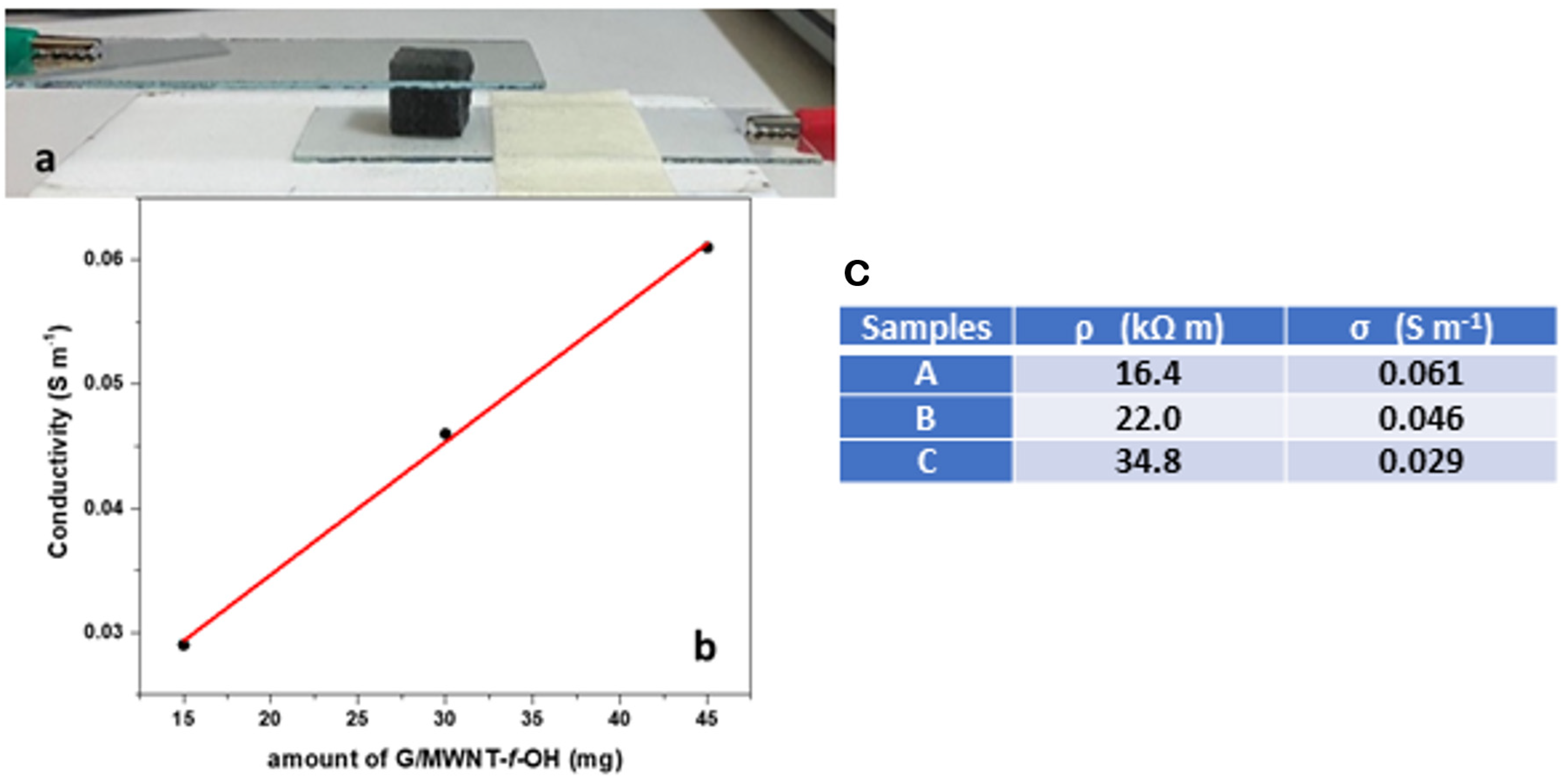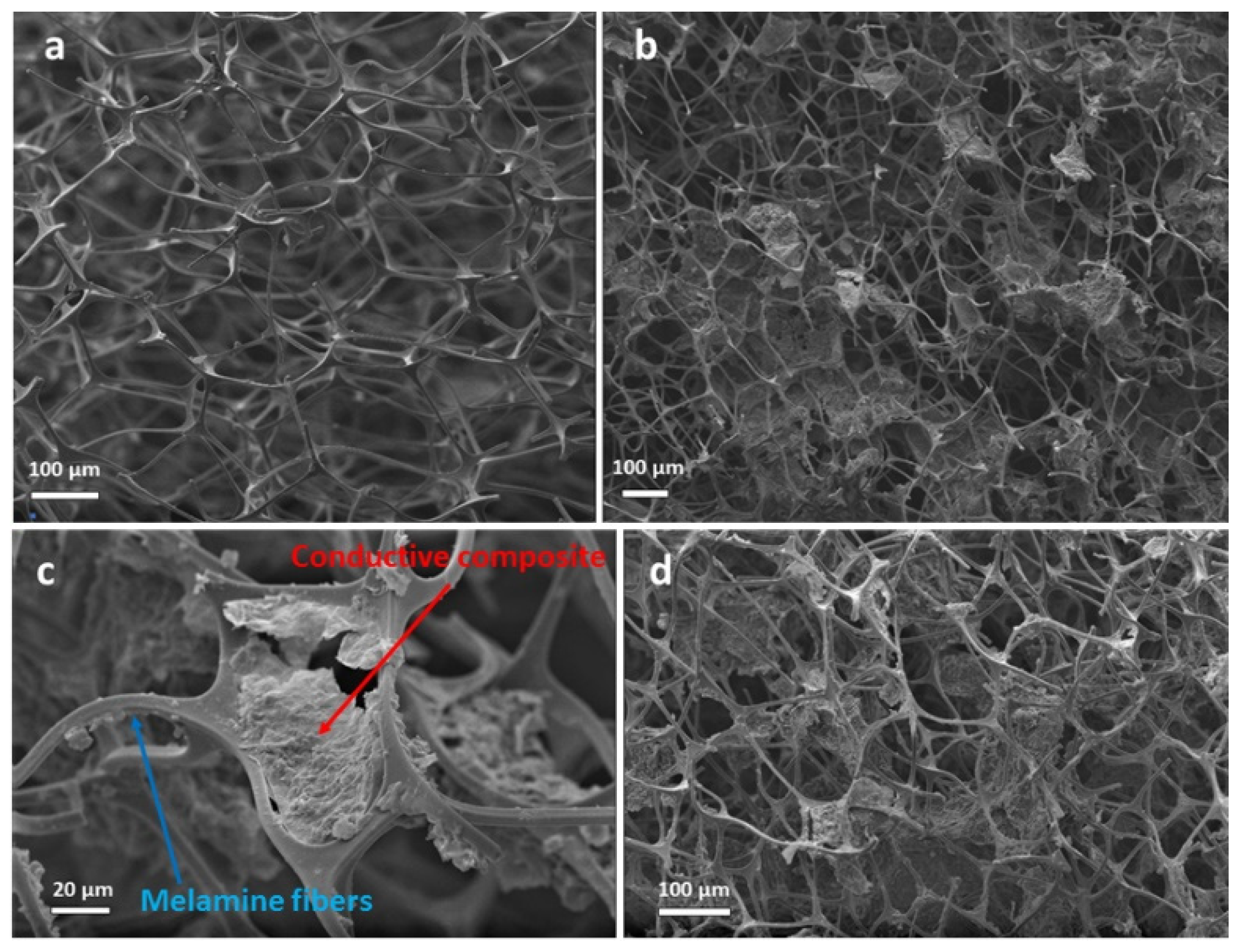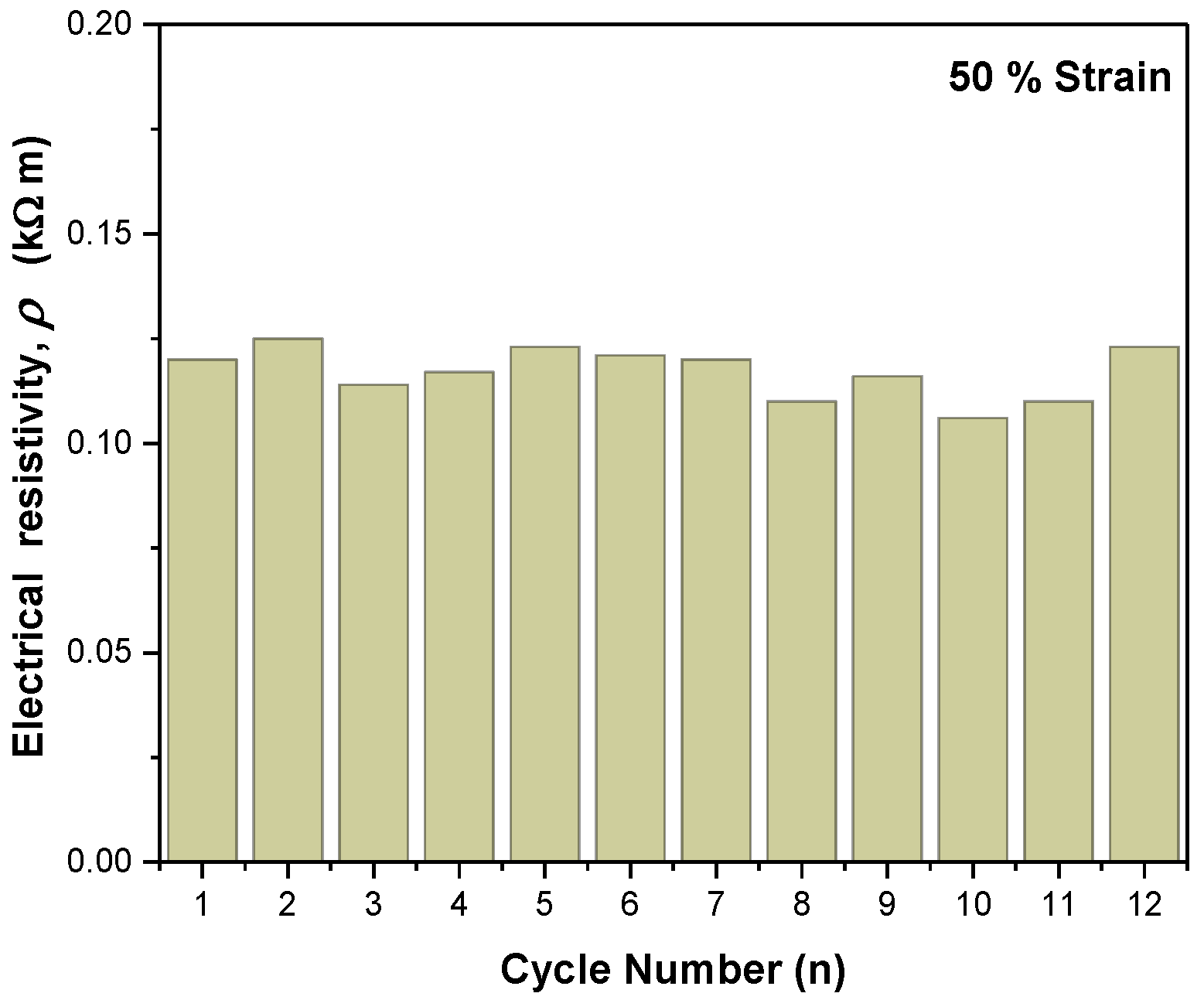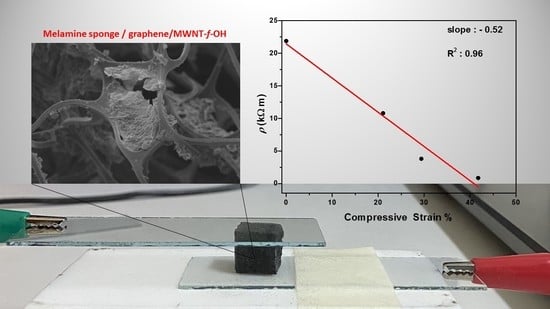Highly Elastic Melamine Graphene/MWNT Hybrid Sponge for Sensor Applications
Abstract
:1. Introduction
2. Materials and Methods
3. Results and Discussion
4. Conclusions
Author Contributions
Funding
Institutional Review Board Statement
Informed Consent Statement
Data Availability Statement
Conflicts of Interest
References
- Allen, M.J.; Tung, V.C.; Kaner, R.B. Honeycomb Carbon: A Review of Graphene. Chem. Rev. 2010, 110, 132–145. [Google Scholar] [CrossRef] [PubMed]
- Backes, C.; Abdelkader, A.M.; Alonso, C.; Andrieux-Ledier, A.; Arenal, R.; Azpeitia, J.; Balakrishnan, N.; Banszerus, L.; Barjon, J.; Bartali, R.; et al. Production and processing of graphene and related materials. 2D Mater. 2020, 7, 022001. [Google Scholar] [CrossRef]
- Georgakilas, V.; Otyepka, M.; Bourlinos, A.B.; Chandra, V.; Kim, N.; Kemp, K.C.; Hobza, P.; Zboril, R.; Kim, K.S. Functionalisation of graphene. Chem. Rev. 2012, 112, 6156–6214. [Google Scholar] [CrossRef]
- Cao, M.; Su, J.; Fan, S.; Qiu, H.; Su, D.; Li, L. Wearable piezoresistive pressure sensors based on 3D graphene. Chem. Eng. J. 2021, 406, 126777. [Google Scholar] [CrossRef]
- Rinaldi, A.; Tamburrano, A.; Fortunato, M.; Sarto, M.S. A Flexible and Highly Sensitive Pressure Sensor Based on a PDMS Foam Coated with Graphene Nanoplatelets. Sensors 2016, 16, 2148. [Google Scholar] [CrossRef] [Green Version]
- Ge, G.; Cai, Y.; Dong, Q.; Zhang, Y.; Shao, J.; Huang, W.; Dong, X. A flexible pressure sensor based on rGO/polyaniline wrapped sponge with tunable sensitivity for human motion detection. Nanoscale 2018, 10, 10033–10040. [Google Scholar] [CrossRef]
- Georgakilas, V.; Demeslis, A.; Ntararas, E.; Kouloumpis, A.; Dimos, K.; Gournis, D.; Zbořil, R. Hydrophilic nanotube supported graphene–water dispersible carbon superstructure with excellent conductivity. Adv. Funct. Mater. 2015, 25, 1481–1487. [Google Scholar] [CrossRef]
- Secor, E.B.; Hersam, M.C. Emerging Carbon and Post-Carbon Nanomaterial Inks for Printed Electronics. J. Phys. Chem. Lett. 2015, 6, 620–626. [Google Scholar] [CrossRef]
- Song, S.; Shen, H.; Wang, Y.; Chu, X.; Xie, J.; Zhou, N.; Shen, J. Biomedical application of graphene: From drug delivery, tumor therapy, to theranostics. Colloids Surf. B Biointerfaces 2020, 185, 110596. [Google Scholar] [CrossRef]
- Ge, P.; Zhang, L.; Zhao, W.; Yang, Y.; Sun, W.; Ji, X. Interfacial Bonding of Metal-Sulfides with Double Carbon for Improving Reversibility of Advanced Alkali-Ion Batteries. Adv. Funct. Mater. 2020, 30, 1910599. [Google Scholar] [CrossRef]
- Velasco, A.; Ryu, Y.K.; Boscá, A.; Ladrón-de-Guevara, A.; Hunt, E.; Zuo, J.; Pedrós, J.; Calle, F.; Martinez, J. Recent trends in graphene supercapacitors: From large area to microsupercapacitors. Sustain. Energy Fuels 2021, 5, 1235–1254. [Google Scholar] [CrossRef]
- Angelopoulou, P.; Vrettos, K.; Georgakilas, V.; Avgouropoulos, G. Graphene aerogel modified carbon paper as anode electrode for lithium-ion batteries. Chem. Select 2020, 5, 2719–2724. [Google Scholar] [CrossRef]
- Sun, X.; Huang, C.; Wang, L.; Liang, L.; Cheng, Y.; Fei, W.; Li, Y. Recent Progress in Graphene/Polymer Nanocomposites. Adv. Mater. 2021, 33, 2001105. [Google Scholar] [CrossRef]
- Jakubczak, M.; Jastrzębska, A.M. A Review on Development of Ceramic-Graphene Based Nanohybrid Composite Systems in Biological Applications. Front. Chem. 2021, 9, 685014. [Google Scholar] [CrossRef]
- Ramírez, C.; Belmonte, M.; Miranzo, P.; Osendi, M.I. Applications of Ceramic/Graphene Composites and Hybrids. Materials 2021, 14, 2071. [Google Scholar] [CrossRef]
- Ibrahim, A.; Klopocinska, A.; Horvat, K.; Abdel Hamid, Z. Graphene-Based Nanocomposites: Synthesis, Mechanical Properties, and Characterizations. Polymers 2021, 13, 2869. [Google Scholar] [CrossRef]
- Tang, G.; Jiang, Z.G.; Li, X.; Zhang, H.B.; Dasari, A.; Yu, Z.Z. Three-dimensional graphene aerogels and their electrically conductive composites. Carbon 2014, 77, 592–599. [Google Scholar] [CrossRef]
- Pottathara, Y.B.; Tiyyagura, H.R.; Ahmad, Z.; Sadasivunic, K.K. Graphene Based Aerogels: Fundamentals and Applications as Supercapacitors. J. Energy Storage 2020, 30, 101549. [Google Scholar] [CrossRef]
- Li, C.; Shi, G. Three-dimensional graphene architectures. Nanoscale 2012, 4, 5549. [Google Scholar] [CrossRef]
- Hu, H.; Zhao, Z.; Wan, W.; Gogotsi, Y.; Qiu, J. Ultralight and Highly Compressible Graphene Aerogels. Adv. Mater. 2013, 25, 2219–2223. [Google Scholar] [CrossRef]
- Imae, I. Reduction of Graphene Oxide Using an Environmentally Friendly Method and Its Application to Energy-Related Materials. Coatings 2021, 11, 297. [Google Scholar] [CrossRef]
- Park, J.; Sharma, J.; Jafta, C.J.; He, L.; Meyer, H.M., III; Li, J.; Keum, J.K.; Nguyen, N.A.; Polizos, G. Reduced Graphene Oxide Aerogels with Functionalization-Mediated Disordered Stacking for Sodium-Ion Batteries. Batteries 2022, 8, 12. [Google Scholar] [CrossRef]
- Jing, J.; Qian, X.; Si, Y.; Liu, G.; Shi, C. Recent Advances in the Synthesis and Application of Three-Dimensional Graphene-Based Aerogels. Molecules 2022, 27, 924. [Google Scholar] [CrossRef]
- Hernández-Ferrer, J.; Benito, A.M.; Maser, W.K.; García-Bordejé, E. Hybrids of Reduced Graphene Oxide Aerogel and CNT for Electrochemical O2 Reduction. Catalysts 2021, 11, 1404. [Google Scholar] [CrossRef]
- Vrettos, K.; Georgakilas, V. Graphene aerogel growth on functionalized carbon fibers. Molecules 2020, 25, 1295. [Google Scholar] [CrossRef] [Green Version]
- Vrettos, K.; Angelopoulou, P.; Papavasiliou, J.; Avgouropoulos, G.; Georgakilas, V. Sulfur doped Graphene Aerogels reinforced with Carbon Fibers as Electrode Materials. J. Mater. Sci. 2020, 55, 9676–9685. [Google Scholar] [CrossRef]
- Liu, W.; Jiang, H.; Ru, Y.; Zhang, X.; Qiao, J. Conductive Graphene−Melamine Sponge Prepared via Microwave Irradiation. ACS Appl. Mater. Interfaces 2018, 10, 24776–24783. [Google Scholar] [CrossRef]
- Wu, H.; Li, S.; Shao, Y.; Jin, X.; Qi, X.; Yang, J.; Zhou, Z.; Wang, Y. Melamine foam/reduced graphene oxide supported form-stable phase change materials with simultaneous shape memory property and light-to thermal energy storage capability. Chem. Eng. J. 2020, 379, 122373. [Google Scholar] [CrossRef]
- Cheng, L.; Feng, J. Facile fabrication of stretchable and compressible strain sensors by coating and integrating low-cost melamine foam scaffolds with reduced graphene oxide and poly (styrene-b-ethylene-butylene-b-styrene). Chem. Eng. J. 2020, 398, 125429. [Google Scholar] [CrossRef]
- Feng, Y.; Yao, J. Design of Melamine Sponge-Based Three-Dimensional Porous Materials toward Applications. Ind. Eng. Chem. Res. 2018, 57, 7322–7330. [Google Scholar] [CrossRef]
- Fan, Y.; Tian, Z.; Wang, F.; He, J.; Ye, X.; Zhu, Z.; Sun, H.; Liang, W.; Li, A. Enhanced Solar-to-Heat Efficiency of Photothermal Materials Containing an Additional Light-Reflection Layer for Solar-Driven Interfacial Water Evaporation. ACS Appl. Energy Mater. 2021, 4, 2932–2943. [Google Scholar] [CrossRef]
- Sun, S.; Tang, S.; Chang, X.; Wang, N.; Wang, D.; Liu, T.; Lei, Y.; Zhu, Y. A bifunctional melamine sponge decorated with silver-reduced graphene oxide nanocomposite for oil-water separation and antibacterial applications. Applied Surface Science 2019, 473, 1049–1061. [Google Scholar] [CrossRef]
- Liang, J.; Zhao, Z.; Tang, Y.; Hao, X.; Wang, X.; Qiu, J. Covalent Bonds-Integrated Graphene Foam with Superb Electromechanical Properties as Elastic Conductor and Compressive Sensor. Carbon 2019, 147, 206–213. [Google Scholar] [CrossRef]
- Georgakilas, V.; Koutsioukis, A.; Belessi, V.; Zboril, R. Highly conductive water-based polymer/graphene nanocomposites for printed electronics. Chem. Eur. J. 2017, 23, 8268–8274. [Google Scholar]
- Liu, Y.; Wang, H.; Zhao, W.; Zhang, M.; Qin, H.; Xie, Y. Flexible, Stretchable Sensors for Wearable Health Monitoring: Sensing Mechanisms, Materials, Fabrication Strategies and Features. Sensors 2018, 18, 645. [Google Scholar] [CrossRef] [Green Version]
- Yang, C.; Liu, W.; Liu, N.; Su, J.; Li, L.; Xiong, L.; Long, F.; Zou, Z.; Gao, Y. Broken Graphene Aerogel to Fragments for Piezoresistive Pressure Sensor with a Higher Sensitivity. ACS Appl. Mater. Interfaces 2019, 11, 33165–33172. [Google Scholar] [CrossRef]




| Samples | Melamine Sponge (mg) | G/MWNT-f-OH (mg) | Cellulose (mg) |
|---|---|---|---|
| A | 10 | 45 | 10 |
| B | 10 | 28 | 10 |
| C | 10 | 15 | 10 |
Publisher’s Note: MDPI stays neutral with regard to jurisdictional claims in published maps and institutional affiliations. |
© 2022 by the authors. Licensee MDPI, Basel, Switzerland. This article is an open access article distributed under the terms and conditions of the Creative Commons Attribution (CC BY) license (https://creativecommons.org/licenses/by/4.0/).
Share and Cite
Fragkogiannis, C.; Koutsioukis, A.; Georgakilas, V. Highly Elastic Melamine Graphene/MWNT Hybrid Sponge for Sensor Applications. Molecules 2022, 27, 3530. https://doi.org/10.3390/molecules27113530
Fragkogiannis C, Koutsioukis A, Georgakilas V. Highly Elastic Melamine Graphene/MWNT Hybrid Sponge for Sensor Applications. Molecules. 2022; 27(11):3530. https://doi.org/10.3390/molecules27113530
Chicago/Turabian StyleFragkogiannis, Christos, Apostolos Koutsioukis, and Vasilios Georgakilas. 2022. "Highly Elastic Melamine Graphene/MWNT Hybrid Sponge for Sensor Applications" Molecules 27, no. 11: 3530. https://doi.org/10.3390/molecules27113530
APA StyleFragkogiannis, C., Koutsioukis, A., & Georgakilas, V. (2022). Highly Elastic Melamine Graphene/MWNT Hybrid Sponge for Sensor Applications. Molecules, 27(11), 3530. https://doi.org/10.3390/molecules27113530







